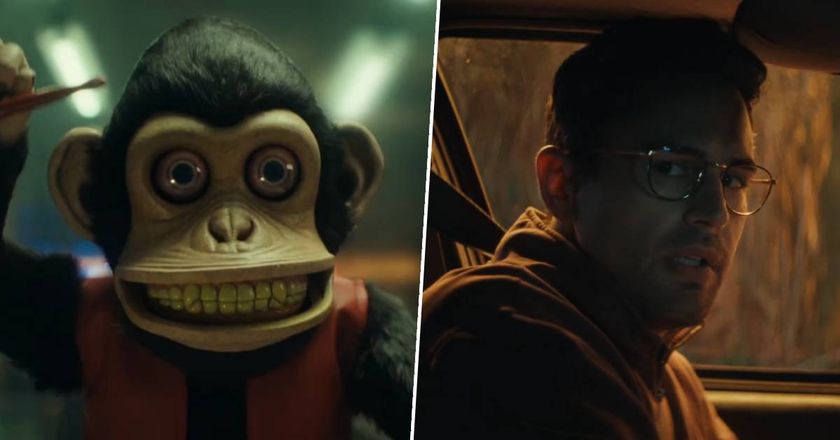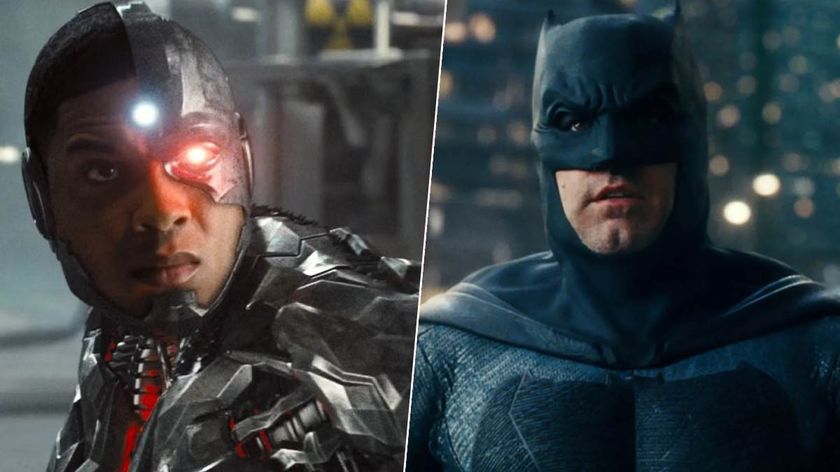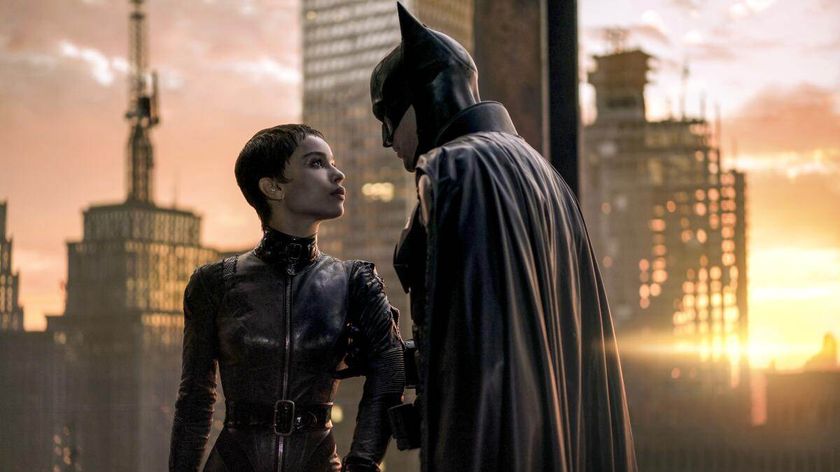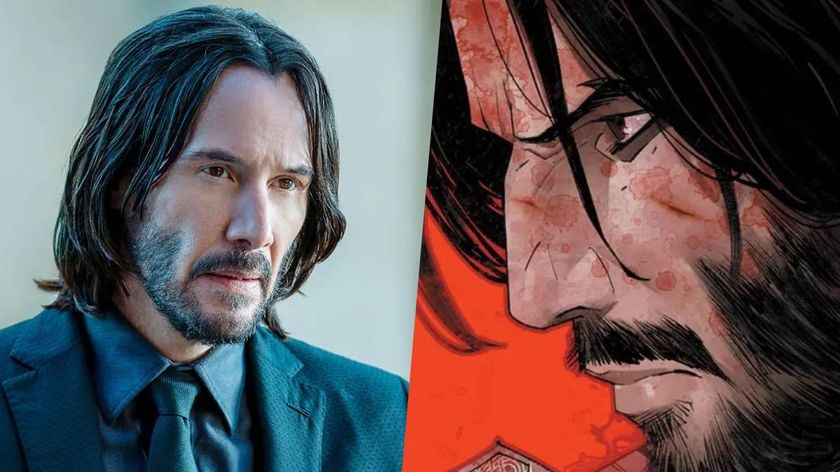The Story Behind Movies & Videogames
From ET to generation Xbox and beyond...
Nothing compares to Hollywood’s on/off affair with gaming. Total Film charts 30 years of love, litigation and end-of-level bosses while looking ahead to the next 12 months of play/watch collaborations…
E.T Phones home...
The 18-wheeler trucks started rolling out of the Atari warehouse on Thursday 22 September 1983. Their cargo: millions of Atari VCS cartridges of E.T. The Extra Terrestrial, the most hyped game in the company’s history.
Their destination: a landfill site in Alamogordo, New Mexico. Arriving at the desert dump, the trucks emptied their once precious cargo. Cartridges bearing E.T.’s wrinkled prune face scattered into the dust.
Each truckload cost Atari $500 to dump but the real cost to the fledgling videogame industry ran into the millions. E.T. The Extra-Terrestrial – the birth child of Steven Spielberg and Atari – killed Hollywood’s love affair with videogames overnight and almost crashed the industry itself.
Four years earlier, Atari had been in rude health. By 1979, the company’s 2600 Video Computer System (VCS) was in homes all across America and Asteroids was a multi-million dollar hit.
Hollywood had already recognised the potential and the threat. Warner Communications had bought Atari in 1976 for $28m and by 1982 the Atari VCS 2600 was hosting the first ever movie tie-in Raiders Of The Lost Ark – a button-pushing franchise that’s continued right up to LEGO Indiana Jones – created by a young, bearded programmer called Howard Scott Warshaw.
It sold over a million copies and turned Warshaw into the videogame equivalent of a movie star. “It sure felt like that,” he laughs on the phone from California. “I was hobnobbing with Steven Spielberg, going into stores and seeing people playing my games and getting so excited.
Sign up for the Total Film Newsletter
Bringing all the latest movie news, features, and reviews to your inbox
It totally blew my head wide open. America suddenly became the Pac-Man nation and when I told people I made videogames they treated me as if I was an astronaut in the ’60s.”
Next: Hollywood Under Threat... [page-break]
Hollywood Under Threat…
As videogame sales increased, movies looked like they were under threat. Disney tapped into the zeitgeist with Tron yet other Hollywood studios felt under siege from a new business model.
“There isn’t a company in the US at the moment that isn’t hoping to get into videogames,” said Tron helmer Steven Lisberger in the autumn of 1982.
“You hear it the whole time: ‘We’re in the meat-packing business, but my son’s hoping to start a videogames division.’ Yes there is a danger that movies are going to end up being expensive commercials for videogames. The whole thing is moving so fast it’s crazy.” Oh, those heady days...
When Atari signed a deal worth around $22m with Spielberg and Universal to create a video game based on E.T. it looked like a licence to print money.
Spielberg agreed on condition that the “certifiable genius” Warshaw would be in charge of it. Warshaw agreed but faced one huge hurdle.
While most videogames took six months to design and create, deadline chaos meant E.T. had to be turned around in just six weeks.
Few programmers could have got a finished game completed in that time. Warshaw did but there was just one problem. The game proved too frustrating; E.T.’s quest to find the missing pieces of his intergalactic phone forcing players into spending most of their time falling into pits that had to be slowly levitated out of.
In his own inimitable style Warshaw had trumpeted the Atari E.T. as “the game that would make the movie famous”. It didn’t quite pan out like that.
Atari actually sold a million-odd copies on hype alone, yet the company had overstretched itself, paying too much for the licence and producing too many cartridges. Bad word of mouth killed sales and the glut helped fuel the videogame bust of ’83.
Left with a mountain of unsellable cartridges and recording a $564m loss, Atari decided to bury E.T. – literally. Hollywood 1, Videogames 0.
Next: Into The Lair... [page-break]
Into The Lair…
Disney wasn’t happy about the dragons. Everyone knew that Don Bluth, a former animator at the studio, drew some of the best fire-breathing reptiles around, but after setting up his own animation studio with a bunch of ex-Disney renegades in the early ’80s, Bluth realised it was difficult to compete with Uncle Walt’s clout.
Their first movie, The Secret Of NIMH (1982), was critically acclaimed but a box office flop. While Bluth licked his wounds, he was approached by Rick Dyer of Advanced Microcomputer Systems (AMS) who introduced him to the concept of “interactive movies”.
The arcade game Dragon’s Lair was born and Disney was royally pissed... Unlike every other arcade game in the early ’80s, Dragon’s Lair didn’t use vector graphics or blocky 8bit sprites.
It looked like a cartoon with Bluth’s animated sequences letting the player control Dirk the Daring as he set off to rescue Princess Daphne.
Under the cabinet’s hood was an industrial Pioneer laser disc player that cued up animated sequences in response to the player’s actions. Each cabinet cost $4,000. But the wow factor was worth four times that.
Queues began to line up around Dragon’s Lair cabinets whenever they were switched on. It was gorgeous to look at. It was also bloody hard with machines sucking up $3-$4 for just 30 seconds of frustrating play (arcade managers were making around $200 a day per machine).
Down the road I think we’ll see more film companies approach videogames via their own film productions,” predicted Bluth’s animation director Gary Goldman at the time.
“Rather than take the character from a film and create a game around it, they will take the movie and at the same time produce a game based on the actual live-action or animation from the film.”
Next: A revolution stirs... [page-break]
A revolution stirs...
By 1984 almost every major Hollywood studio had a videogaming subsidiary. Tie-in games like Ghostbusters and Aliens on the ZX Spectrum and Commodore 64 did their best to bring the movies into your living room.
In 1987 the aptly titled Cinemaware brought cinema-style adventures to the Commodore Amiga and Atari ST – a playable game of The Three Stooges used digitised pictures from the movies, while movie themed games like Rocket Ranger paid homage to Saturday morning serials.
Not all games were so movie fixated. When Nintendo released its Entertainment System, the NES, in the US in 1985 (with a certain moustachioed Italian plumber as its mascot) the videogame market received a shot in the arm.
It was a brilliant time to be a gamer as the industry began to give Hollywood a run for its money and between 1985 and 1988 some of the key franchises of the industry were born from Super Mario Bros. to The Legend of Zelda, Metal Gear Solid and Final Fantasy.
Everyone wanted to be associated with videogames. “I love playing Mario on my Atari,” wittered Baywatch babe Yasmine Bleeth. Hollywood watched from the sidelines as videogaming became cool all over again.
Next: Keeping It Real... [page-break]
Keeping It Real...
When Sega released its first CD-Rom drives in 1992, ‘Full Motion Video’ (FMV) was hailed as the future. Games like Wing Commander III, Night Trap and Rebel Assault featured FMV of real-life actors who the player controlled.
“These games are like movies, with scripts almost two feet thick,” claimed Mark Hamill, who supplemented his Star Wars income playing Col ‘Maverick’ Blair in the Wing Commander series, a trend that’s continued right up to this year’s shooter WET, starring Eliza Dushku and, er, Malcolm McDowell...
While Hollywood and gaming were tarting to see eye-to-eye, the new realism brought problems of its own.
Censors railed against the synthesized sprites ripping out each other’s spinal chords in Mortal Kombat and Night Trap was vilified in the 1993 Senate hearings on videogame violence, mainly because most of the politicians didn’t understand the game – you were trying to save the college girls from vampires, not rape and murder.
Hollywood looked on, glad it wasn’t in the line of fire for a change. Was Hollywood worried about FMV? Maybe a little bit.
As videogames looked like they were closing the gap between movies and gaming, producers undoubtedly knew that a paradigm shift was happening. Licensed games were big business.
Hits like Batman Returns on the Super Nintendo proved that. Shelves groaned with titles like Lethal Weapon, Dune and Terminator 2. There was even a Plan 9 From Outer Space adventure game. But the Holy Grail was ‘synergy’ – combining a game and movie to boost the profits of both.
When Super Mario Bros. became the first game to shift 10m copies, it was only a matter of time until a studio exec said, “I want that... as a movie”.
Next: Adaptation... [page-break]
Adaptation…
“It was par for the course,” reckons Annabel Jankel, co-director of Super Mario Bros. “Every comic book had been adapted into movies. It was inevitable to try and translate something like this to the screen.”
Being a pioneer is sometimes lonely work, though, and big questions remained over how to turn a game into a movie experience. “We had this poster that Nintendo produced for us.
“It had all the characters from the games and we tried to include as many of them as possible into the story. There was the mushroom, King Koopa and Iggy and Spike. We were choosing bits from the game rather than trying to make a direct translation.
“Neither co-director Rocky Morton or I were enthusiastic gamers, which might have been something to do with the end result...”
Even though Super Mario Bros. was a huge box office flop, the floodgates opened. Double Dragon and Street Fighter appeared the following year with beat ’em ups being more cost effective to realise on-screen than Shigeru Miyamoto’s Mushroom Kingdom.
Next: Post-Pub PlayStation... [page-break]
Post-Pub PlayStation...
By 1995 things were changing. As Sony’s PlayStation launched, a new breed of director arrived in Hollywood. “I was definitely the first generation of filmmakers who grew up with a vivid appreciation of videogames,” says Paul WS Anderson.
“I remember Space Invaders in the arcades in Scarborough, it was like the monolith in 2001: A Space Odyssey suddenly appearing with all these kids clustered around it. It really had a magnetic pull.
“In the early ’90s, I used to play Mortal Kombat in the arcades in Soho between movie meetings.” So when Mortal Kombat was optioned for a movie adaptation, who better to helm it?
Anderson’s Mortal Kombat was the first videogame movie smash hit, taking $122m at the international box office. “There was this belief that videogame movies just didn’t work and my feeling was the opposite,” he says.
"I thought they were a justifiable intellectual property to adapt. It was just that no one knew how to make a movie that reflected the game and was enjoyable on its own terms.”
Next: Generation Xbox... [page-break]
Generation Xbox…
Where do you draw the line between Hollywood and videogames? By the time Y2K arrived it was hard to tell. In the autumn of 2000, Sony unveiled the PlayStation 2.
Punters queued for hours to get hold of the minimalist black boxes. It wasn’t just a games machine. It played CDs and DVDs. It was the hub of the living room.
“The PlayStation 2 computer entertainment system is not the future of videogame entertainment,” intoned the slightly biased Kazuo Hirai, president of Sony Computer Entertainment America. “It is the future of entertainment period.”
Meanwhile in cinemas, Lara Croft: Tomb Raider and Resident Evil made multi-million dollar ‘synergy’ between movies and videogames add up. Even Microsoft realised consoles were the future and unveiled their Xbox in 2001 and their seventh generation console the Xbox 360 in 2005.
Nintendo withdrew from the graphics arms race, yet its underpowered Wii turned out to be a revolution and made pick-up-and-play gaming fun for all the family (watch out for gran on Need For Speed: Nitro this Christmas, though...).
Next: Battle lines drawn, blurred... [page-break]
Battle lines drawn, blurred…
In the last 10 years, the line between blockbuster games and blockbuster movies has continued to blur. Think of the epic sweep of Halo 3 or the narrative mastery of Grand Theft Auto IV’s sprawling story.
Produced by teams that are as big as movie crews and with budgets to match, Blockbuster games are eating into blockbuster movies’ turf. At the same time, movies from The Matrix trilogy to 300 to Gamer have begun to look like games. Is the ground between them narrowing?
“The studios are still a little scared of videogames because they see them as competition in some ways, sucking up valuable dollars,” says Paul WS Anderson.
“It used to be when you released a movie you worried about what sporting events were happening that weekend – would everyone be at home watching the football or baseball finals?
“In the last few years the studios are now saying: ‘Halo 3 is coming out this weekend, people are going to spend $50 on it and they’re probably not going to go to the cinema for days.’ There’s definitely an element of competition there.”
Good luck Roland Emmerich’s 2012 then, what with Call Of Duty: Modern Warfare 2 coming out just ahead of the disaster flick’s release.
Next: Co-opetition... [page-break]
Co-opetition…
But do movies and games really have to be locked in a PvP deathmatch? What if they’re destined for co-op play instead?
Producer Lorenzo di Bonaventura (Doom) thinks that could be the way forward. “It’s inevitable that we’re going to figure out how to do synergy eventually,” he says, although he admits that the idea of developing stories across both mediums is ambitious.
“The problem is it’s very hard to predict when the script’s going to be ready, when you can make it, when the best release date is going to be. It’s hard enough to do that just with a movie, let alone with a movie and a game.”
One of his current projects – game/movie The Wheelman – is a case in point, delays meaning the game (starring Vin Diesel) preceded the movie (also starring Vin Diesel) by a huge window.
Plus there remains the age-old problem: movies and games tell stories differently. It’s something that leading figures in both industries are trying to solve.
“They’re different experiences,” says di Bonaventura. “The adrenalin rush aspect of a videogame is very specific to your direct interaction with it. I don’t think movies can replace that. It’s something that videogames have uniquely to themselves.”
That hasn’t stopped various titles trying – including Doom, whose fi nal reel turned into a first-person shooter – though results have been mixed.
With Sam Raimi inked in to direct Warcraft and Heavy Rain looking to rewrite digital storytelling, it’s a great time to be a movie fan and a gamer. The future’s bright, the future’s playable.
Like This? Then try...
Sign up for our free weekly newsletter here .
Follow us on Twitter here .
The Total Film team are made up of the finest minds in all of film journalism. They are: Editor Jane Crowther, Deputy Editor Matt Maytum, Reviews Ed Matthew Leyland, News Editor Jordan Farley, and Online Editor Emily Murray. Expect exclusive news, reviews, features, and more from the team behind the smarter movie magazine.

















